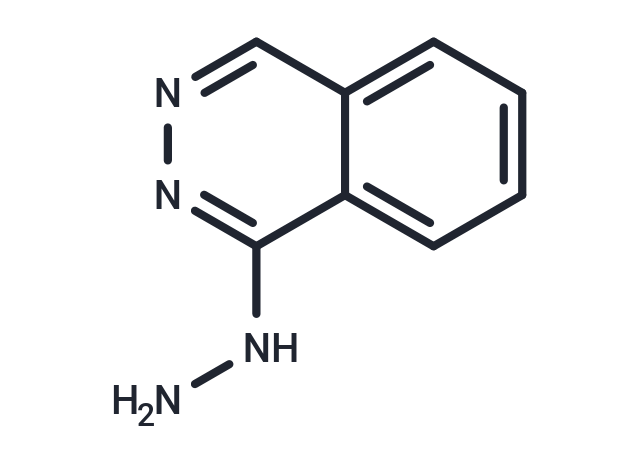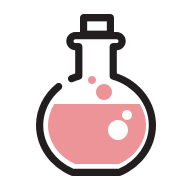- Remove All
 Your shopping cart is currently empty
Your shopping cart is currently empty
Shopping Cart
Hydralazine hydrochloride
Catalog No. T1613Cas No. 304-20-1
Alias Hydralazine HCl, Apresoline
Hydralazine hydrochloride (Apresoline) is the hydrochloride salt of hydralazine, a phthalazine derivative with antihypertensive and potential antineoplastic activities. Hydralazine alters intracellular calcium release and interferes with smooth muscle cell calcium influx, resulting in arterial vasodilatation. This agent also inhibits the phosphorylation of myosin protein and chelation of trace metals required for smooth muscle contraction, resulting in an increase in heart rate, stroke volume, and cardiac output. In addition to its cardiovascular effects, hydralazine inhibits DNA methyltransferase, which may result in inhibition of DNA methylation in tumor cells.

Hydralazine hydrochloride
Catalog No. T1613Alias Hydralazine HCl, ApresolineCas No. 304-20-1
Hydralazine hydrochloride (Apresoline) is the hydrochloride salt of hydralazine, a phthalazine derivative with antihypertensive and potential antineoplastic activities. Hydralazine alters intracellular calcium release and interferes with smooth muscle cell calcium influx, resulting in arterial vasodilatation. This agent also inhibits the phosphorylation of myosin protein and chelation of trace metals required for smooth muscle contraction, resulting in an increase in heart rate, stroke volume, and cardiac output. In addition to its cardiovascular effects, hydralazine inhibits DNA methyltransferase, which may result in inhibition of DNA methylation in tumor cells.
| Pack Size | Price | Availability | Quantity |
|---|---|---|---|
| 200 mg | $36 | In Stock | |
| 500 mg | $73 | In Stock | |
| 1 g | $106 | In Stock |
Add to Cart
Add to Quotation
Bulk & Custom
Questions
View MoreSelect Batch
Purity:99.86%
Contact us for more batch information
All TargetMol products are for research purposes only and cannot be used for human consumption. We do not provide products or services to individuals. Please comply with the intended use and do not use TargetMol products for any other purpose.Product Introduction
Bioactivity
Chemical Properties
| Description | Hydralazine hydrochloride (Apresoline) is the hydrochloride salt of hydralazine, a phthalazine derivative with antihypertensive and potential antineoplastic activities. Hydralazine alters intracellular calcium release and interferes with smooth muscle cell calcium influx, resulting in arterial vasodilatation. This agent also inhibits the phosphorylation of myosin protein and chelation of trace metals required for smooth muscle contraction, resulting in an increase in heart rate, stroke volume, and cardiac output. In addition to its cardiovascular effects, hydralazine inhibits DNA methyltransferase, which may result in inhibition of DNA methylation in tumor cells. |
| In vitro | Hydralazine impairs up-regulation of RAG-2 gene expression and reduces secondary Ig gene rearrangements. Hydralazine subverts B lymphocyte tolerance to self and contributes to generation of pathogenic autoreactivity by disrupting receptor editing. [1] Hydralazine directly scavenges free acrolein, decreasing intracellular acrolein availability and thereby suppressing macromolecular adduction. Hydralazine inhibits cross-linking if adding 30 min after commencing acrolein exposure but is ineffective if added after a 90-min delay. [2] Hydralazine (0.1-10 mM) inhibits both extracellular and intracellular ROS production by inflammatory macrophages, by a ROS-scavenging mechanism probably affecting superoxide radical (O(2)(*-))-generation by xanthine oxidase (XO) and nicotinamide adenine dinucleotide/nicotinamide adenine dinucleotide phosphate (NADH/NADPH) oxidase. Hydralazine (0.1-10 mM) significantly reduces NO(*) generation, and this effect is attributable to an inhibition of NOS-2 gene expression and protein synthesis. Hydralazine also effectively blocks COX-2 gene expression which perfectly correlated with a reduction of protein levels and PGE(2) synthesis. [3] Hydralazine protects against not only acrolein-mediated injury, but also compression in guinea pig spinal cord ex vivo. Hydralazine can significantly alleviate acrolein-induced superoxide production, glutathione depletion, mitochondrial dysfunction, loss of membrane integrity, and reduces compound action potential conduction. [4] |
| In vivo | Hydralazine affords strong, dose-dependent protection against the increases in plasma marker enzymes but not the hepatic glutathione depletion produced by allyl alcohol in mice. [5] |
| Alias | Hydralazine HCl, Apresoline |
| Molecular Weight | 196.64 |
| Formula | C8H9ClN4 |
| Cas No. | 304-20-1 |
| Smiles | NNC1=NN=CC2=CC=CC=C12 |
| Relative Density. | 1.2961 g/cm3 (Estimated) |
Storage & Solubility Information
| Storage | Powder: -20°C for 3 years | In solvent: -80°C for 1 year | Shipping with blue ice. | ||||||||||||||||||||
| Solubility Information | H2O: 10 mM, Sonication is recommended. DMSO: Insoluble | ||||||||||||||||||||
Solution Preparation Table | |||||||||||||||||||||
H2O
| |||||||||||||||||||||
Calculator
In Vivo Formulation Calculator (Clear solution)
Please enter your animal experiment information in the following box and click Calculate to obtain the mother liquor preparation method and in vivo formula preparation method:
Mother liquor preparation method: 2 mg of drug dissolved in 50 μL DMSO (mother liquor concentration of 40 mg/mL), if you need to configure a concentration that exceeds the solubility of the product, please contact us first.
(mother liquor concentration of 40 mg/mL), if you need to configure a concentration that exceeds the solubility of the product, please contact us first.
Preparation method for in vivo formula: Take 50 μL DMSO main solution, add 300 μLPEG300
main solution, add 300 μLPEG300 mix well and clarify, then add 50 more μL Tween 80, mix well and clarify, then add 600 more μLSaline/PBS/ddH2O
mix well and clarify, then add 50 more μL Tween 80, mix well and clarify, then add 600 more μLSaline/PBS/ddH2O mix well and clarify
mix well and clarify
For Reference Only. Please develop an appropriate dissolution method based on your laboratory animals and route of administration.
Dose Conversion
You can also refer to dose conversion for different animals. More Dose Conversion
Sci Citations
Tech Support
Please see Inhibitor Handling Instructions for more frequently ask questions. Topics include: how to prepare stock solutions, how to store products, and cautions on cell-based assays & animal experiments, etc
Keywords
orally activeMAOInhibitorinhibitHypoxia-inducible factorsHydralazine HydrochlorideHydralazine hydrochlorideHydralazineHIFsHIFProlylHydroxylaseHIF-PHHIF/HIFProlylHydroxylaseHIF/HIF Prolyl-HydroxylaseHIF/HIF ProlylHydroxylaseHIF Prolyl-HydroxylaseHIF ProlylHydroxylaseHIFarterial vesselantihypertensive
Related Tags: buy Hydralazine hydrochloride | purchase Hydralazine hydrochloride | Hydralazine hydrochloride cost | order Hydralazine hydrochloride | Hydralazine hydrochloride chemical structure | Hydralazine hydrochloride in vivo | Hydralazine hydrochloride in vitro | Hydralazine hydrochloride formula | Hydralazine hydrochloride molecular weight

Copyright © 2015-2025 TargetMol Chemicals Inc. All Rights Reserved.



